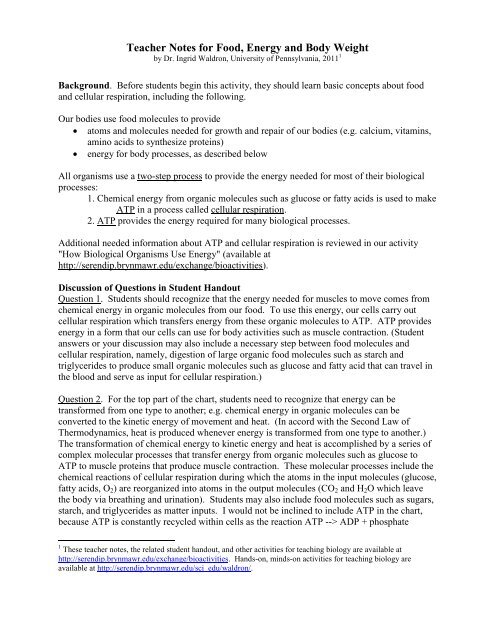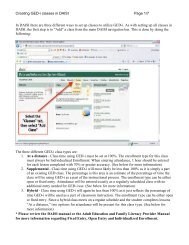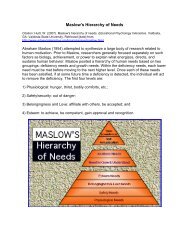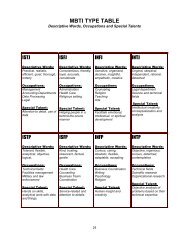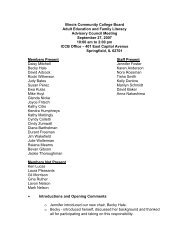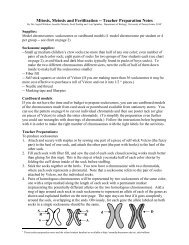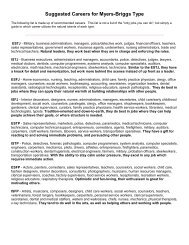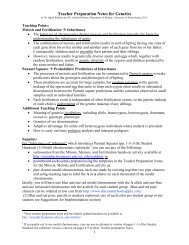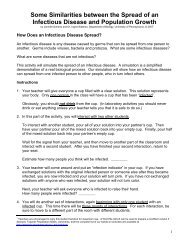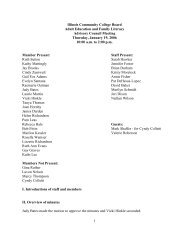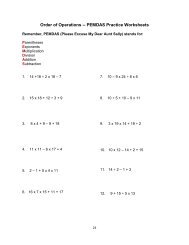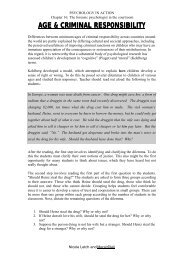Teacher Notes for Food, Energy and Body Weight
Teacher Notes for Food, Energy and Body Weight
Teacher Notes for Food, Energy and Body Weight
Create successful ePaper yourself
Turn your PDF publications into a flip-book with our unique Google optimized e-Paper software.
<strong>Teacher</strong> <strong>Notes</strong> <strong>for</strong> <strong>Food</strong>, <strong>Energy</strong> <strong>and</strong> <strong>Body</strong> <strong>Weight</strong><br />
by Dr. Ingrid Waldron, University of Pennsylvania, 2011 1<br />
Background. Be<strong>for</strong>e students begin this activity, they should learn basic concepts about food<br />
<strong>and</strong> cellular respiration, including the following.<br />
Our bodies use food molecules to provide<br />
atoms <strong>and</strong> molecules needed <strong>for</strong> growth <strong>and</strong> repair of our bodies (e.g. calcium, vitamins,<br />
amino acids to synthesize proteins)<br />
energy <strong>for</strong> body processes, as described below<br />
All organisms use a two-step process to provide the energy needed <strong>for</strong> most of their biological<br />
processes:<br />
1. Chemical energy from organic molecules such as glucose or fatty acids is used to make<br />
ATP in a process called cellular respiration.<br />
2. ATP provides the energy required <strong>for</strong> many biological processes.<br />
Additional needed in<strong>for</strong>mation about ATP <strong>and</strong> cellular respiration is reviewed in our activity<br />
"How Biological Organisms Use <strong>Energy</strong>" (available at<br />
http://serendip.brynmawr.edu/exchange/bioactivities).<br />
Discussion of Questions in Student H<strong>and</strong>out<br />
Question 1. Students should recognize that the energy needed <strong>for</strong> muscles to move comes from<br />
chemical energy in organic molecules from our food. To use this energy, our cells carry out<br />
cellular respiration which transfers energy from these organic molecules to ATP. ATP provides<br />
energy in a <strong>for</strong>m that our cells can use <strong>for</strong> body activities such as muscle contraction. (Student<br />
answers or your discussion may also include a necessary step between food molecules <strong>and</strong><br />
cellular respiration, namely, digestion of large organic food molecules such as starch <strong>and</strong><br />
triglycerides to produce small organic molecules such as glucose <strong>and</strong> fatty acid that can travel in<br />
the blood <strong>and</strong> serve as input <strong>for</strong> cellular respiration.)<br />
Question 2. For the top part of the chart, students need to recognize that energy can be<br />
trans<strong>for</strong>med from one type to another; e.g. chemical energy in organic molecules can be<br />
converted to the kinetic energy of movement <strong>and</strong> heat. (In accord with the Second Law of<br />
Thermodynamics, heat is produced whenever energy is trans<strong>for</strong>med from one type to another.)<br />
The trans<strong>for</strong>mation of chemical energy to kinetic energy <strong>and</strong> heat is accomplished by a series of<br />
complex molecular processes that transfer energy from organic molecules such as glucose to<br />
ATP to muscle proteins that produce muscle contraction. These molecular processes include the<br />
chemical reactions of cellular respiration during which the atoms in the input molecules (glucose,<br />
fatty acids, O 2 ) are reorganized into atoms in the output molecules (CO 2 <strong>and</strong> H 2 O which leave<br />
the body via breathing <strong>and</strong> urination). Students may also include food molecules such as sugars,<br />
starch, <strong>and</strong> triglycerides as matter inputs. I would not be inclined to include ATP in the chart,<br />
because ATP is constantly recycled within cells as the reaction ATP --> ADP + phosphate<br />
1 These teacher notes, the related student h<strong>and</strong>out, <strong>and</strong> other activities <strong>for</strong> teaching biology are available at<br />
http://serendip.brynmawr.edu/exchange/bioactivities. H<strong>and</strong>s-on, minds-on activities <strong>for</strong> teaching biology are<br />
available at http://serendip.brynmawr.edu/sci_edu/waldron/.
provides energy <strong>for</strong> muscle contraction <strong>and</strong> cellular respiration reconstitutes ATP by the reaction<br />
ADP + phosphate --> ATP.<br />
Discussion of this question can be used to emphasize the important point that energy can be<br />
converted to other <strong>for</strong>ms of energy <strong>and</strong> the atoms in molecules can be arranged into other<br />
molecules, but energy can not be converted to matter or vice versa in biological processes (in<br />
accord with the First Law of Thermodynamics). This point is also important <strong>for</strong> question 4.<br />
Question 3. Students can use their answer to question 2 to recognize that cellular respiration<br />
converts many of the molecules in food to CO 2 <strong>and</strong> H 2 O which leave the body via breathing,<br />
urination <strong>and</strong> sweating. In addition, beverages <strong>and</strong> some foods (e.g. fruits <strong>and</strong> vegetables)<br />
contain a lot of H 2 O; the body retains only enough H 2 O to replace the H 2 O lost by breathing,<br />
sweating, etc. Also, some food molecules are not absorbed from the digestive system <strong>and</strong> leave<br />
the body in feces. Since the average American consumes more calories than needed <strong>for</strong> body<br />
activities, some of the weight of the food is retained, as discussed in the next question.<br />
Estimated annual food consumption in the US includes 75 pounds of added fats <strong>and</strong> oils, 152<br />
pounds of caloric sweeteners, 195 pounds of meat <strong>and</strong> fish, 200 pounds of grains, 593 pounds of<br />
dairy, <strong>and</strong> 708 pounds of fruits <strong>and</strong> vegetables (http://www.usda.gov/factbook/chapter2.pdf).<br />
Notice that the types of foods at the beginning of this list have high calorie density; foods in the<br />
last two categories weigh substantially more per calorie consumed, in large part because they<br />
contain a lot of water.<br />
Question 4. This question provides the opportunity to discuss the relationships <strong>and</strong> distinctions<br />
between food, calories <strong>and</strong> energy -- concepts that students often confuse. <strong>Food</strong> contains organic<br />
molecules which have chemical energy stored in the bonds between atoms. There are many<br />
other types of energy, including the kinetic energy of moving muscles <strong>and</strong> heat (the kinetic<br />
energy in the r<strong>and</strong>om motion of atoms <strong>and</strong> molecules). In addition to energy, food provides<br />
atoms <strong>and</strong> molecules needed <strong>for</strong> growth <strong>and</strong> repair of our bodies. A calorie is a unit of measure<br />
of energy; we use the lower case calories throughout because it is more familiar to students, even<br />
though we are actually referring to Calories or kilocalories.<br />
If a person eats food with more calories than needed <strong>for</strong> body activities, some of the organic<br />
molecules contained in the food will not be used <strong>for</strong> cellular respiration, so the atoms in these<br />
molecules will not be given off as CO 2 <strong>and</strong> H 2 O. The body uses surplus organic molecules to<br />
synthesize triglycerides which are stored in fat cells in our adipose tissue <strong>and</strong> glycogen (a<br />
polymer of glucose) which is stored in the liver <strong>and</strong> muscles. Less than a day's worth of energy<br />
is stored in the <strong>for</strong>m of glycogen (~800 calories). In contrast, a normal weight person has<br />
enough stored fat to provide energy <strong>for</strong> about two months (~140,000 calories). Fat provides<br />
more energy per gram than carbohydrates or proteins (9 calories per gram vs. 4) <strong>and</strong> our fat<br />
stores also have less associated water; given the mobility of animals, this greater energy density<br />
is an important advantage <strong>for</strong> fat as the main energy storage molecule in animals.


